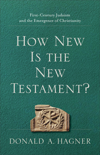
Overview
What is so new about the New Testament? Senior scholar Donald Hagner tackles the issue of how distinct early Christianity was from the first-century Judaism from which it emerged. He surveys newness in the entire New Testament canon, examining the evidence for points of continuity and discontinuity between formative Judaism and early Christianity. Hagner's accessible analysis of the New Testament text shows that despite Christianity's thorough Jewishness, from the beginning dramatic newness was an essential aspect of this early literature.
Table of Contents
Contents
1. The Question of Continuity and Discontinuity
2. The Gospels of Mark and Matthew
3. The Gospel of Luke
4. The Acts of the Apostles
5. The Gospel of John and the Johannine Letters
6. The Pauline Corpus
7. Hebrews and the Catholic Letters
8. The Apocalypse
9. Newness in the New Testament: Continuity and Discontinuity
Conclusion
Indexes
1. The Question of Continuity and Discontinuity
2. The Gospels of Mark and Matthew
3. The Gospel of Luke
4. The Acts of the Apostles
5. The Gospel of John and the Johannine Letters
6. The Pauline Corpus
7. Hebrews and the Catholic Letters
8. The Apocalypse
9. Newness in the New Testament: Continuity and Discontinuity
Conclusion
Indexes
Endorsements
"Old or new? Continuity or discontinuity? In his survey of the New Testament, Donald Hagner demonstrates why it is not a case of either/or but of both/and--and indeed why continuity and discontinuity are paradoxically intertwined. Hagner's book should be compulsory reading for anyone who persists in supposing that the Old Testament is irrelevant for Christian faith."
Morna D. Hooker, Lady Margaret's Professor Emerita, University of Cambridge
"Against the current emphasis on continuity between the New Testament and the Hebrew Scripture, Hagner seeks to restore the balance by looking at what is new about the new era. The book is a reminder that what came with Jesus not only was tied to the promises of old but also brought fresh realities and a renewed hope. Hagner's survey of key New Testament texts shows that what came was a freshness that made old things new."
Darrell L. Bock, senior research professor of New Testament studies, Dallas Theological Seminary
"How new is the New Testament? Hagner's conclusion is 'Not altogether new, but newer than you think.' His answer is convincing. He works his way book by book through the New Testament, assessing degrees of continuity and discontinuity between the Old Testament and the New. In the process, he adds valuable nuance and precision to the debate over the so-called new perspective on Paul, while successfully avoiding any implication that the 'newness' of Christianity somehow invalidates or supersedes Judaism. A welcome contribution."
J. Ramsey Michaels, professor emeritus, Missouri State University
"For far too long, Judaism and the Jewish law was presented as the toxin for which the Christian gospel was the antidote. The unspeakable evils of the Holocaust provided the necessary force to reverse that pendulum's motion, but in some circles it has swung too far in the direction of downplaying the decisive importance of what was new in the proclamation of God's acts in Jesus and in the giving of the Spirit. In this accessible volume, veteran scholar Donald Hagner sets forth the evidence for discontinuity that cannot be ignored or written off with integrity as we seek to balance the rootedness of Jesus and the early church in the faith of Israel with the new wine that could not be contained in the wineskins of the parent religion."
David A. deSilva, author of The Jewish Teachers of Jesus, James, and Jude: What Earliest Christianity Learned from the Apocrypha and Pseudepigrapha
"How New Is the New Testament? addresses a very difficult and sensitive topic. Professor Hagner is eminently qualified to write such a book, which reflects decades of biblical scholarship and theological reflection. The relationship between Israel and the church and the place of the Jewish people in God's ongoing work are questions of the utmost importance. This book must be engaged."
Craig A. Evans, John Bisagno Distinguished Professor of Christian Origins, Houston Baptist University
"I have looked forward to this book for some time. Although Hagner appreciates and understands continuity between the Testaments, he also recognizes necessary discontinuity, often neglected in recent theological discussion. Even though there are a few places where I would have argued the point differently, I am pleased that Don has taken the time to make such an encompassing and convincing case for the 'dramatic newness' that is found in the New Testament."
Stanley E. Porter, president, dean, professor of New Testament, and Roy A. Hope Chair in Christian Worldview, McMaster Divinity College
Author
Donald A. Hagner
Donald A. Hagner (PhD, University of Manchester) is George Eldon Ladd Professor Emeritus of New Testament and senior professor of New Testament at Fuller Theological Seminary in Pasadena, California. He is the author of The New Testament: A Historical and Theological Introduction, Encountering the Book of Hebrews, The Jewish Reclamation of Jesus, New Testament Exegesis and Research: A Guide for Seminarians, and commentaries on Matthew and Hebrews. He is also coeditor of the New International Greek Testament Commentary and an ordained minister in the Presbyterian Church (USA).